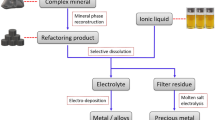Abstract
The addition of dolomite to iron ore pellets improves high temperature reduction properties, primarily by increasing their softening point and reducibility. This study was made to ascertain the compositional ranges within which dolomite fluxed magnetite pellets show such an improvement over good acid pellets. A variety of compositions with MgO levels from 1 to 2 wt pct and CaO/SiO2 ratios of 0.6 to 1.8 were prepared using Hibbing magnetic concentrate. These compositions were balled and then pot-grate fired to various temperatures. Petrographic examination and electron microprobe analyses were used to characterize the phase assemblages. Reduction characteristics were also evaluated. As evidenced by the following petrographically observed relationships, the CaO/SiO2 ratio (c/S) was found to be the controlling factor for pellet microstructure: a) The low c/S (< 0.8) pellets were predominantly oxide-bonded, b) the intermediate c/S (0.8 to 1.3) pellets were slag- and oxide-bonded, and c) the high C/S (> 1.3) pellets were mostly calcium ferrite-bonded. Intermediate c/S compositions contain more magnesioferrite than do either low or high basicity compositions. Pellets must be fired to a high enough temperature to generate sufficient liquid for ion transport but not so high as to cause pellets to stick together. Well-fired pellets with a c/S of 1.3 or less performed adequately in low temperature degradation tests. Pellets with a c/S of 0.8 or greater displayed satisfactory swelling behavior. Therefore, we determined that pellets within a c/S range of 0.8 to 1.3 are technically acceptable. Pellets containing 1.5 wt pct MgO had the best reduction characteristics, but all fluxed compositions reduced faster and more completely than did acid pellets. Increasing MgO content up to 2.0 pct increased the softening temperature by 165‡C over acid pellets. On the basis of pellet test results and taking into consideration the auxiliary influence of economic and operating considerations, we determined the optimum composition of dolomite fluxed Hibbing pellets to be 1.5 pct MgO and a C/S of 0.8.
Similar content being viewed by others
References
O. Saeki, K. Taguchi, I. Nishida, I. Fujita, M. Onoda, and O. Tuchiya:Agglomeration 77, vol. 2, pp. 803–15, AIME, NY, 1977.
P. A. Ilmoni:Jernkont. Ann., 1975, vol. 159, pp. 119–45.
G. Thanning:LKAB News Special Report, Stockholm, Sweden, October 1974.
L. Bentell and G. Mathisson:Scand. J. Metall, 1978, vol. 7, pp. 230–36.
A. E. Bence and A. L. Albee:J. Geol., 1968, vol. 76, pp. 382–403.
A. L. Albee and L. Ray:Anal Chem., 1970, vol. 42, pp. 1408–14.
H. A. Kortmann and O. P. Burghardt:Agglomeration 77, vol. 1, pp. 219–42, AIME, NY, 1977.
A. E. Paladino:J. Am. Ceram. Soc., 1960, vol. 43, pp. 183–91.
F. W. Frazer, H. Westenberger, K. H. Boss, and W. Thumm:Int. J. Min. Proc., 1975, vol. 1, pp. 353–65.
E. F. Osborn and A. Muan:Phase Diagrams for Ceramists, pp. 204 and 228, Am. Ceram. Soc., Columbus, OH, 1964.
Author information
Authors and Affiliations
Rights and permissions
About this article
Cite this article
Friel, J.J., Erickson, E.S. Chemistry, microstructure, and reduction characteristics of dolomite-fluxed magnetite pellets. Metall Trans B 11, 233–243 (1980). https://doi.org/10.1007/BF02668407
Received:
Issue Date:
DOI: https://doi.org/10.1007/BF02668407




